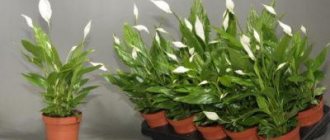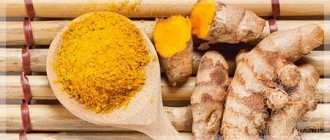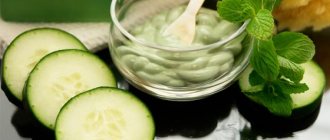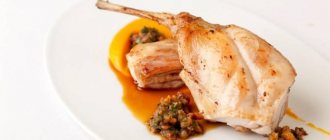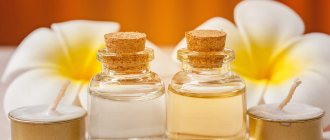For centuries, our ancestors collected wild herbs and spices. They used them to prepare elixirs and decoctions that helped cure ailments and diseases. Medical science has recently begun to take herbs and spices a little more seriously and carefully, paying attention to how they can benefit human health. Most people have a range of herbs and spices in their kitchen for cooking, but few realize the full potential of these products. It turns out that herbs and spices can do much more than add flavor to food. So, 10 of the healthiest herbs and spices.
Sage
In the Middle Ages, sage was believed to have the ability to heal and ward off plague. Modern science says that sage improves the functioning of the brain and memory. This beneficial herb inhibits the breakdown of a chemical messenger in the brain called acetylcholine, which is found deficient in patients suffering from Alzheimer's disease. One study found that patients with mild to moderate Alzheimer's disease showed significant improvement after taking sage extract for four months.
Saffron
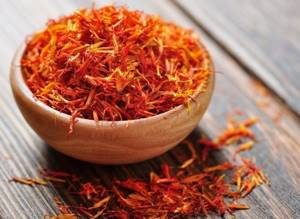
This is the most expensive seasoning in the world. Since ancient times, doctors believed that the substances contained in it enhance brain activity. Saffron contains almost the entire vitamin B group, including potassium, magnesium, zinc and copper. They also have a positive effect on the nervous system.
You should not use saffron uncontrollably. Exceeding the safe dose (40 veins per year) leads to poisoning and irreversible consequences. A single dose should not exceed 2 veins.
In cooking, the range of uses of the spice is very wide. Saffron gives meat dishes a unique, pleasant aroma, and desserts and dough products a delicate creamy-yellow color. If you plan to season the food with saffron, there is no need to add other spices. The taste of the dish will be ruined.
To stimulate brain function, an infusion of saffron veins is prepared. They are dried crocus stigmas. You can only take 2 pieces. They are ground into powder and stirred in a glass of warm milk or water. Take before meals.
Turmeric
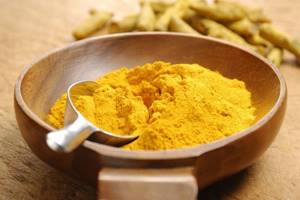
One of the most useful spices is turmeric. It is widely used in Indian cuisine and provides a number of amazing health benefits. Benefits of turmeric include lowering cholesterol, healing wounds, treating arthritis, and preventing cancer. Cucurma contains a powerful anti-inflammatory compound called curcumin.
LiveInternetLiveInternet
ITDalee
all posts by the author
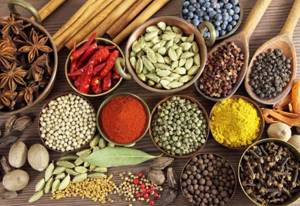
In many traditional cultures, spices are used to increase energy, relieve stress, improve the functioning of the nervous and digestive systems, treat colds, headaches and many other diseases. While cooking, you can explore interesting food concepts that combine flavor and medicinal properties, use natural spices and different cooking methods. Spices and spices determine the taste, aroma, and often the color of cooked food. With the help of spices you can influence your mood and cultivate certain character traits.
Asafoetida (hing) is an aromatic resin from the roots of the plant Ferula asafoetiela. The taste is somewhat reminiscent of garlic, but significantly surpasses it in medicinal properties. Asafoetida was very popular as a spice and as a medicine in the Roman Empire. For the treatment of migraines (headaches) it is one of the best remedies. Using asafoetida in cooking, you can get rid of polyarthritis, radiculitis, and osteochondrosis. Asafoetida restores the hormonal functions of the adrenal glands, gonads, and calms the nervous system. It can be added to first and second courses to taste.
Clove - (laung) . Added to first and second courses, dishes with potatoes and cabbage. Suppresses putrefactive intestinal flora, removes bad breath, strengthens the stomach and liver. It neutralizes toxins well, cleanses the blood, strengthens the heart, and removes ama. Improves memory by normalizing cerebral circulation. Warms the cold nature of Vata and Kapha people. Contains vitamin C and carotene.
orchitsa (pau) – (mustard seeds). Used in almost all dishes (potato dishes, cabbage, soups) - strengthens the heart muscle, eliminates blood clots, is a good antiseptic, improves vision, strengthens hair, neutralizes toxins. It calms the nervous system well during stress, relieves migraines, tension, helps with the inability to relax and overwork, and treats depressive conditions. Normalizes high blood pressure. Stabilizes the hormonal functions of the adrenal glands and gonads. It is used in food for polyarthritis, osteochondrosis, colds, atherosclerosis, and coronary heart disease. Normalizes lung function after colds. Used for cases of indigestion, blockage of sweat glands, vegetative-vascular dystonia, and water retention in the body. Used as food to prevent helminthiasis. Be careful, as it enlarges Pita! If there is an imbalance, do not use Pita. Not used for kidney diseases.
Ginger (adrak) is the ground, light brown, gnarled root of the Zingiber officinabis plant. Used in all types of Indian dishes. Ginger is an unsurpassed medicine. It perfectly treats most skin and allergic diseases, bronchial asthma, and cerebrovascular accidents. Ginger restores immunity, increases mental stability in stressful situations, and eliminates spasms in the intestines. In addition, it perfectly activates digestion. Ginger tea restores strength during physical and mental fatigue. Ginger treats colds and lung diseases, increases the absorption of oxygen by lung tissue. Normalizes the activity of the thyroid gland.
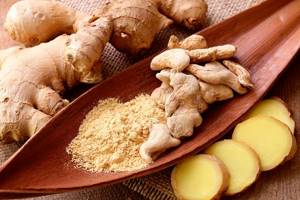
Curry . Already a fairly well-known spice, which is added to first and second courses: drinks, sauces, salads, borscht, stewed vegetables. Has tonic properties. Normalizes Pita. Promotes wound healing and treatment of pneumonia.
Chili pepper . Used in preparing first and second courses. It has a blood purifying effect, suppresses putrefactive intestinal microflora, eliminates constipation, kills worms and intestinal parasites. Increases blood circulation, eliminates blood clots. Cleanses sweat glands. Very rich in vitamin C, has a diaphoretic effect. Used for colds. Contains vitamins: B, B2, E, PP, P, carotenes. Stimulates Vata, reduces Kapha, increases Pita.
Saffron (kesar) Relieves overexcitation and nervous diseases. Calms, relieves convulsions and spasms, treats hysteria, normalizes the number of heart contractions. Relieves attacks of convulsive cough. It has a diuretic and diaphoretic effect, helps digest milk. Contains vitamins: B1, B2, carotene, carotenoids, flavonoids. Balances doshas, improves skin color and condition. Purifies the blood, reduces blood clots, detoxifies the liver, tonic for the heart and nervous system. Increases sensuality and sexual performance.
Turmeric (haldi) is the root of a plant from the ginger family; when ground it is a bright yellow powder. It has an excellent therapeutic effect for polyarthritis, osteochondrosis, immunity disorders, liver and kidney diseases. Organic turmeric powder restores strength in case of muscle weakness, cures duodenal ulcer, and treats diabetes. It also cleanses the blood and has a diuretic effect. It is used in small quantities to color rice dishes and add a fresh, spicy aroma to vegetables, soups, and appetizers.
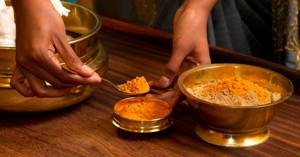
Mango powder (amchur) is the ground fruit of the mango tree Mangifera indica. Used in drinks, vegetable dishes, sour dishes and salads. Mango powder improves mood and treats depression. It has a positive effect on hearing loss, activates the small intestine, improves blood circulation in the lung tissue, and relieves muscle fatigue. Normalizes calcium metabolism in the body, treats myopia.
Cardamom (elaichi) belongs to the ginger family Elettaria cardamonum. Its pale green pods are used mainly to flavor drinks and sweet dishes. Cardamom refreshes the oral cavity and stimulates digestion. It treats coronary heart disease well and relieves pain in cardiovascular pathology. Normalizes blood supply in the vascular wall, relieves vascular spasms. Cardamom reduces the activity of the thyroid gland while increasing its function, and has an expectorant and antispasmodic effect in bronchitis.

Curry leaves (curry patti or meetha neem) are the dried leaves of the curry tree Murraya Koenigri, native to Southwest Asia. They are added to vegetable dishes, soups, and cereal dishes. Curry leaves help with enterocolitis, hepatitis, cholecystitis. They cure inflammatory processes in the kidneys well and increase diuresis. Promote wound healing, treatment of pneumonia, polyarthritis, osteochondrosis, inflammation of the bladder. They cleanse the blood of protein waste infections, treat sore throat, skin furunculosis and other bacterial infections.
Kalinji seeds (Kalinji) are black seeds of the Niqella sativum plant, shaped like a teardrop. The seeds of this plant are very similar in appearance to onion seeds, but in taste and quality they have nothing in common with it. They are used in vegetable dishes, in baked goods with vegetable filling and give them a unique aroma. Kalinji seeds improve brain activity and promote digestion. They have a diuretic effect and activate the nervous system. Kalinja seeds increase the activity of the retina, treat myopia, and also have an antidepressant effect.
Nutmeg (jaiphal) is the kernel of the tropical tree Myristica Fragrans. Grated nutmeg is used in small quantities (sometimes in combination with other spices) to flavor puddings, milk sweets and vegetable dishes. Pairs very well with spinach and winter squash. Like many spices, it stimulates digestion and cures chronic rhinitis. It perfectly treats many benign tumors, for example, mastopathy. Improves the activity of the immune system. Treats staphylococcal infections, has a beneficial effect on tuberculosis, and prevents the occurrence of malignant tumors. Coriander seeds (hara dhaniya) are the highly aromatic seeds of the Coriandrum sativum plant. One of the main spices used in Indian cuisine. Coriander seed oil helps digest starchy foods and root vegetables. Coriander adds a fresh spring aroma to food. Coriander seeds are a strong stimulant of the body's immune system. They give good results in the treatment of benign and malignant tumors, mobilize the body to overcome psychological stress.

Indian Cumin Seeds (Jira Cumin) - White Indian Cumin seeds Cuminum cyminum are an important ingredient in vegetable, rice and snack recipes. In order for cumin seeds to impart their characteristic flavor to food, they must be well roasted. Cumin seeds promote digestion and share the healing properties of Kalinja seeds. Black cumin seeds are darker and smaller than white ones and have a more bitter taste and pungent odor. They do not require as long roasting as white cumin seeds. Cumin seeds give vitality, freshness, stimulate the nervous system, treat gastritis with high acidity, increase kidney activity, and have a diuretic effect. Relieves spasms from small vessels of the skin.
Fennel (souf) is the seed of the plant Foeniculum vulgare. Also known as “sweet cumin”. Its long, pale green seeds are similar to caraway and cumin seeds, but larger in size and different in color. They taste like anise and are used in seasonings. Fennel improves digestion, stimulates the flow of breast milk in nursing mothers and is very useful for gastritis, stomach ulcers and other diseases of the gastrointestinal tract. Fennel improves vision in myopia and is good at reducing high blood pressure. It has an expectorant effect.
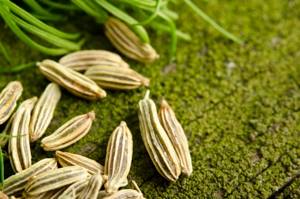
Shambhala (methi) - Trigonella fenumgraecum. Belongs to the legume family. A favorite plant of Indians. Its square-shaped, brownish-beige seeds are indispensable in many vegetable dishes and snacks. Shambhala restores strength and stimulates the flow of breast milk in nursing mothers, and also stimulates digestion and heart function, helps with constipation and colic. Shambhala perfectly treats joints and spine, prevents hypothermia of the extremities. It normalizes the hormonal functions of the adrenal glands and gonads.
Black salt . Black salt is a dark gray salty powder with an eggy odor. Used as a substitute for table salt. Black salt is rich in iodine, potassium, sulfur, iron and other trace elements. It is used in absolutely all dishes where regular salt is added. The downside is a slight eggy taste, but when combined with other spices, it becomes unnoticeable. The advantage is that black salt regulates digestion and does not retain water in the body as much as regular salt. Has a slight laxative effect.
Seasonings of Passion
It is believed that essential oils contained in spices and seasonings not only have a beneficial effect on the gastrointestinal tract, but also significantly increase sexual activity. The ability to ignite passion is attributed to anise, cloves, mustard (seeds), and vanilla. Cinnamon excites, increasing desire, but it affects women and men differently, in the female body it increases the tone of the uterus, but in the east they believe that this spice is especially useful for men, because it improves the functioning of the kidneys, the condition of which is closely related to male strength and sexuality. Cardamom has long been considered the spice of love. Back in the distant Middle Ages, it was one of the obligatory components of love spells. Ginger also increases male strength. There are herbs and spices that, on the contrary, reduce libido: cilantro, mint, tarragon.
Aphrodisiac products - Honey, celery. It is known that the Marquise de Pompadour daily treated Louis XV with homemade soup made from celery, which stimulates the functioning of the sex glands. Having brought the marquise to exhaustion, the tireless monarch went to other favorites.
Combination of spices and herbs with products First and second courses, grain legumes
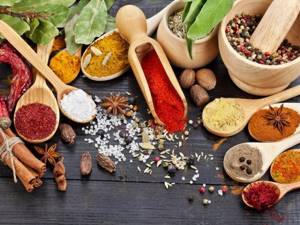
First and second courses of grain legumes
- Peas - ginger, cinnamon, chili, allspice, turmeric, coriander, shamballa, cumin, kalinji, nutmeg, dill (seed), curry, black pepper.
- Buckwheat - allspice, chili, cumin, turmeric, cinnamon, cloves, black mustard, dill (seed), dill (greens), asafoetida, curry.
- Semolina - ginger, turmeric, cinnamon, chili, shambhala, asafoetida, curry, nutmeg.
- Oats - turmeric, allspice, shamballa, cloves, asafoetida, curry, chili, green dill.
- Barley - ginger, cloves, allspice, turmeric, shamballa, asafoetida.
- Wheat - chili, ginger, curry, nutmeg, cardamom.
- Millet - ginger, turmeric, cloves, black mustard, mango (fruit), black pepper, shamballa, curry.
- Rice - chili, ginger, cinnamon, cloves, turmeric, cumin, asafoetida, black mustard, cumin, kalinji.
- Beans - chili, allspice, ginger, cumin, cinnamon, cloves, shamballa, kalinji, nutmeg.
- Yachka - ginger, cloves, allspice, turmeric, shamballa, asafoetida.
Vegetables and fruits
- Green peas - shamballa, chili, ginger, cloves, allspice, curry, mango (fruit).
- Cabbage - curry, turmeric, cinnamon, dill (seed, stem).
- Potatoes - coriander, black pepper, chili, shamballa, kalinji, asafoetida, cinnamon, nutmeg, curry.
- Carrots - chili, allspice, cumin, ginger, cloves, asafoetida, kalinji, turmeric.
- Cucumbers - nutmeg, ginger, fennel, black pepper.
- Bell pepper - allspice, coriander, cinnamon, cloves, curry, cardamom, black pepper, cumin, mango (fruit).
- Tomatoes - asafoetida, shamballa, chili, turmeric, cloves, allspice, nutmeg.
- Radishes - black pepper, cinnamon, nutmeg, black mustard, cumin, cardamom.
- Green radish - chili, cloves, nutmeg, curry, fennel, cardamom.
- Black radish - black pepper, nutmeg, allspice, cinnamon, cumin, ginger, curry.
- Beetroot - cinnamon, allspice, coriander, asafoetida, vanillin, cumin, turmeric, nutmeg, curry, shamballa, dill seed, lemon juice, chili.
- Pumpkin - cardamom, shamballa, chili, mint, ginger, kalinji.
- Apples (in spicy dishes) - chili, ginger, cumin, cloves, cinnamon, kalindzhi, vanillin, nutmeg, nuts, mango, sugar.
- Sweet dishes, salads, pastries, drinks
- Sugar - nutmeg, vanillin, cumin, fennel, cardamom, nutmeg, mango, mint.
- Pineapple - cardamom, cumin.
- Banana - vanillin, mango fruit.
- Hawthorn - ginger, cardamom, cumin, lemon, mint.
- Grapes (raisins) - cardamom, ginger, orange (peels).
- Cherry - cumin, cardamom, lemon, acid, fennel.
- Pomegranate - ginger, fennel.
- Pear - cardamom, mango (fruit), fennel.
- Irga - cumin, cardamom, nutmeg.
- Viburnum - cardamom, cumin, mango fruits.
- Strawberry (“Victoria”) - ginger, lemon peel, mango, cumin.
- Strawberries (wild) - cumin, kalindzhi, fennel, ginger.
- Gooseberries - cumin, fennel, ginger.
- Dried apricots - fennel.
- Lemon - vanillin, fennel, mango.
- Raspberry - mint, cumin, mango fruit.
- Mandarin - mint, cumin, cardamom.
- Sea buckthorn - cumin, fennel, mint, vanillin, mango.
- Red rowan - turmeric, ginger, cardamom, mango, kalinji, cumin.
- Chokeberry - cardamom, curry, fennel, kalindzhi.
- Blue plum - mango fruits, vanillin, fennel, cardamom.
- White plum - mango fruits, cardamom, fennel.
- White currants - lemon, cumin, mint.
- Red currant - lemon, orange (peel), cumin, mango fruit.
- Black currant - cardamom, fennel, vanillin, lemon, kalindzhi.
- Date - cardamom, mango fruit, fennel, vanillin.
- Black bird cherry - cardamom, lemon, vanillin, fennel.
- Apples - fennel, vanillin.
- Strawberries - ginger, lemon peel, mango, nutmeg, kalinji.
Dairy
- Milk - nutmeg, cardamom, turmeric, ginger, cinnamon.
- Yogurt - cumin, black pepper.
- Cheese - cardamom, cumin, turmeric, red and black pepper.
Recipes
A drink for colds (this is a godsend in the winter)!
Ingredients: Ginger, cinnamon, cardamom seeds, black tea.
For a teapot with a volume of 400-500 ml, 1 tablespoon (without a slide) of dry ground ginger, 9 cardamom grains, 1 tablespoon of cinnamon. Tea to taste. Pour boiling water over the ingredients in a preheated container. Close the lid and cover with a towel to keep warm. Leave for a while, let it brew. Use as tea leaves, diluting with boiling water. The drink should not burn the larynx or cause heartburn. When consumed there should be a pleasant warming effect. (To prepare a tonic drink, similar in properties to coffee, you need to replace ginger in the recipe with nutmeg, in a volume of more than half a thumbnail per serving).
Coffee Substitute Drink
If you make a three-spice drink: 250 ml per serving. cinnamon (1 tsp), cardamom (3-4 grains), nutmeg (volume of more than half the nail), it will have the properties of coffee. For similarity, you can add chicory.
Basil
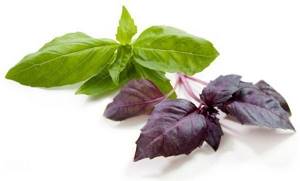
Basil is known as a carminative and can be used to treat indigestion. This plant contains a compound called eugenol, which relieves muscle spasms. One of the many beneficial properties of basil is its use as an expectorant to relieve the symptoms of colds and bronchial infections.
Spices in masks
Although all spices have much in common, they cannot be called universal or identical. Each of them has its own special function; some rejuvenate and give a fresh look, while others can be used to tighten facial skin.
"Golden" turmeric mask
Take a teaspoon of spice, mix with a tablespoon of sour cream or cream, you can also add a little honey. Apply the resulting mixture to your face and rinse off after 20-25 minutes with cool water. If a yellowish tint remains, a regular tonic will help remove it. Turmeric is a powerful antioxidant that promotes deep cleansing of the skin and improves blood flow. It will be useful for aging, dry and sensitive skin, as well as as a therapeutic procedure for rosacea and a tendency to acne.
Ginger mask
Mix half a teaspoon of ground ginger, a tablespoon of cream and the same amount of any cosmetic clay. Apply the mixture to your face for 15-20 minutes, rinse with water and be sure to apply a nourishing cream. Ginger has a warming effect, rejuvenates the skin, and improves complexion.
Magic carnation
Cloves are most often used in the form of cosmetic oil or small portions in masks made from clay, sour cream, cream and fruit. You shouldn’t apply it for a long time – ten minutes is enough. Cloves are a powerful antiseptic that gets rid of blackheads and pimples; in addition, it can be used to improve blood circulation.
Fragrant cinnamon
Mix half a teaspoon of cinnamon with a tablespoon of sour cream and apply to your face for about twenty minutes. The remains of the mask are rubbed into the skin, and then rinsed with warm water. This aromatic spice soothes, saturates the skin with vitality, and helps prolong youth due to its high antioxidant content.
Cardamom as lifting
Eastern beauties widely used cardamom to tighten the skin of the face, neck and décolleté. It is enough to add a third of a teaspoon of spice to a tablespoon of sour cream, season the mixture with 5-6 drops of any cosmetic oil and apply to the skin for 10-15 minutes. You need to wash off the mask with warm water.
For a long time, Eastern women fascinated travelers with their beauty - smooth and silky skin, thick and shiny hair and, of course, a mysterious gaze. It's worth taking something from their collection for our charm too!
© 2012, I fly myself. All rights reserved.
Ginger
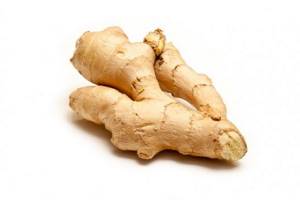
The most famous property of ginger is its ability to calm the stomach and reduce nausea. It is effective in reducing the symptoms of morning sickness and motion sickness, as well as indigestion. Ginger contains a powerful anti-inflammatory substance called gingerol, which is an effective treatment for people suffering from arthritis.
Cinnamon
The bark of an evergreen tree from the laurel family contains vitamins A, B1, B2, C, iron, potassium, calcium, and phosphorus. Cinnamon has antioxidant, antiseptic, antibacterial, anti-inflammatory, and antifungal effects.
Cinnamon scrub. 2 tbsp. Mix spoons of coffee grounds with 1 teaspoon of ground cinnamon and 2 tbsp. spoons of kefir. Massage lightly into face and body, then rinse in shower.
Bath with cinnamon and milk. Add 1 teaspoon of cinnamon to a glass of milk, bring to a boil, strain, and add to the bath. This bath moisturizes the skin, improves superficial capillary circulation and is especially suitable for dry skin prone to flaking.
Article on the topic
Mustard, star anise, ginger and other spices that will help you warm up
General benefit
Spices may include iron, calcium, potassium, magnesium, iodine, sodium, folic and rosmarinic acids, tannins, antioxidants and essential oils. Spices are also rich in vitamins B, C, A, D, PP, E, K and P. Despite this, there are contraindications for consumption:
- individual intolerance;
- allergic reactions;
- gastritis;
- ulcer;
- bronchial asthma;
- cystitis;
- nervous disorders.
Seasonings are quite strong irritants that can trigger the development of certain diseases. Therefore, if you experience the above symptoms, you should completely eliminate certain supplements from your diet.
Attention! You should not take medications together with a dish to which spices have been added: their properties neutralize the effect of the drug.
Red peppers can be harmful. The fact is that it contains capsaicin, an alkaloid that is responsible for its burning properties. If it gets into the eyes, serious damage to the retina can occur, so you need to be very careful when preparing food.
Great care should be taken when using spices with generic names like “Meat Seasoning”, “Herbs de Provence”, etc. They often contain chemical ingredients to make the aroma and taste more intense and pronounced. Before buying such a product, carefully read the composition indicated on the package.
The daily intake of spices is 1-4 g per day. If you follow the dosage and contraindications, seasonings will have an extremely positive effect on the body. However, an increase in the rate can lead to serious complications. For example, a large amount of cinnamon, sage and nutmeg provokes cramps, and an excess of cloves causes a feeling of apathy and lethargy. Pregnant women should avoid saffron and rosemary.
Each of the spices of plant origin has a distinctive taste, aroma and a unique set of beneficial properties. Let's take a closer look at the most beneficial seasonings and spices for health.
Carnation
This natural antiseptic has anti-inflammatory and antifungal effects, and is also effective against parasites. The plant relieves pain and spasms, promotes rapid healing of wounds and abrasions, increases blood pressure, relieves flatulence and bloating. Cloves treat coughs, sore throats and chronic tonsillitis, have a calming effect and reduce the risk of cancer.
Spices are a useful ingredient in the human diet. With the right approach and compliance with the dosage, they can act as analogues of many medications.
The Greenportal team wishes you strong immunity, cheerful mood and productive work on your health!
Oregano
Another name is oregano. The spice has a positive effect on the gastrointestinal tract: soothes mucous membranes, eliminates nausea, improves permeability and fights flatulence, normalizes blood pressure, accelerates metabolism, improves digestion and the functioning of the endocrine system. Oregano reduces the risk of developing cardiovascular diseases and helps with colds - it thins and removes mucus. The spice is very useful for children: it contains vitamin A and beta-carotene, which are necessary for growth and development.
Garlic
Garlic is another spice that has been known for its health benefits since ancient times. Moreover, garlic has been used for a long time to treat various diseases. And of course, it is impossible to forget about garlic if we are talking about the best spices. Thanks to the organic compound allicin
, which gives garlic its characteristic smell, it copes well with colds and even treats mild infections.
If you often get colds, then be sure to add some garlic to your diet. In addition, garlic can reduce the level of total cholesterol and bad
cholesterol (low-density lipoproteins). Finally, garlic can be recommended for people with high blood pressure. Research shows that this spice lowers blood pressure as effectively as some medications.
Ginseng
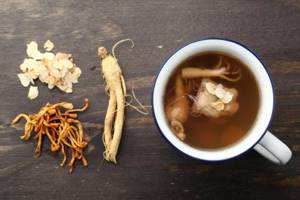
In Eastern countries, eating ginseng is common. They can even eat it whole by boiling it in water, like potatoes. But more often the powder of the dried root is sprinkled on prepared food. It has a specific, peculiar taste. Meat and vegetable dishes, desserts - ginseng as a spice gives them an original taste.
Taking it regularly, you can increase the speed of mental activity and improve abstract thinking. You should not prepare preparations from ginseng yourself, as it is a biologically active substance. It is better to use ready-made dosage forms.
